
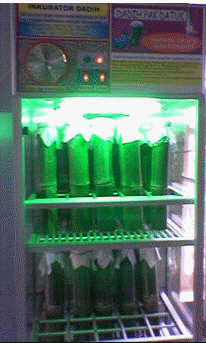
propped against the wall in the corner of the
room, without temperature control
glass Dimension : 40x40x150cm ower: AC 220 60W Control system:
Thermohygro regulator Temperature: 39 °C Humidity: 60% RHP
| Livestock Research for Rural Development 33 (7) 2021 | LRRD Search | LRRD Misssion | Guide for preparation of papers | LRRD Newsletter | Citation of this paper |
Dadih as a typical Minangkabau food has needs to be developed because it is still traditionally processed from generation to generation at home industry centers in West Sumatra, Indonesia. Dadih production potential was observed in 5 dadih production center districts. Dadih is made from buffalo milk which is put into a 250 ml bamboo tube and incubated in an open place for 2-3 days. Repair the incubation using an incubator measuring 40x40x150 cm aluminum frame and glass wall equipped with a thermohygroregulator at a temperature of 39 ºC and humidity of 60%. The average production of buffalo milk is 4.69 liters/day, where 32.01% of this milk is given for the consumption of buffalo calves and 67.99% is used for dadih production. Dadih production has the potential to meet the protein needs of the people of West Sumatra, 63.57 g per capita. The use of an incubator can improve the quality of dadih by decreasing pH 4.32, protein value 9.76, and total bacteria 2.42 x106 within 24 hours. Organoleptically, the dadih incubated with the incubator had better organoleptic sensory values than traditional incubations.
Keywords: bamboo, buffalo, home industry, milk, organoleptic
“Dadih” is a traditional food of the Minangkabau tribe in the province of West Sumatra, Indonesia. Dadih is made from buffalo milk (Bubalus bubalis) which is fermented in a bamboo tube ( Bambusoideae) for 2-3 days. Dadih is white like tofu, slightly sour taste like yogurt or kefir with a distinctive aroma that can arouse appetites. Dadih is very popular with most of the Minangkabau people who are usually eaten with rice as a side dish, or eaten with emping as a side dish and as food in traditional ceremonies and for traditional medicine.
The potential for dadih development as a specific food of Minangkabau is very prospectively as an effort to alleviate poverty and family food security (Disnak 2019). Dadih is a nutrient-rich native food ingredient for the people of West Sumatra (Nuraida 2015) and contains lactic acid bacteriaLactobacillus, Streptococcus, Leuconostoc, and Lactococcus which are useful as a source of probiotics (Wirawati et al 2019). L. plantarum isolates from dadih can remove cyanotoxins which have acute hepatotoxicity and strong tumor activity produced by cyanobacteria (Nybom et al 2008). Other probiotics benefits of dadih are prevention of effects of Hypocholesterolemic, immune system stimulation, and prevention of diarrhea (Nuraida 2014).
The dadih processing in the dadih industry center of West Sumatra is still done traditionally with the knowledge that has been passed down from generation to generation. Dadih is produced from buffalo milk as raw material by relying on the microbes present in the walls of the bamboo tube (Ginting 2018) without the addition of a starter. Common bamboos used for dadih making are gombong bamboo (Gigantochloa verticillata) and ampel bamboo (Bambusa vulgaris) (Wijayanti 2016).
Room temperature during the dadih fermentation process greatly affects the quality of the dadih produced. The bacteria that work in the dadih fermentation process are Streptococcus lactis and Lactobacillus acidophilus which work effectively at an optimum temperature of 38-39 ºC. Fluctuations in room temperature during the day and night resulted in the incubation process being longer and the resulting dadih quality was also low. To improve the quality of dadih products, it is necessary to improve the incubation method which can condition a suitable fermentation environment for dadih bacteria so that it can produce better, better quality, and hygienic dadih. Besides that, as a food product, the appearance of dadih packaging needs to be improved. The bamboo tube which is a characteristic of dadih packaging requires information on the trademark, producer, ingredient composition, license, and expiration date.
Dadih production in West Sumatra is calculated based on statistical data (BPS 2020) and observation data at dadih production centers in West Sumatra, which are located in 5 districts, namely Agam, Sijunjung, Fifty Cities, Solok, and Tanah Datar districts. The statistical data collected was the buffalo population in the last 6 years, then analyzed using the Least Square method (Gomez & Gomez 1984). Observations were made to record milk production, the amount of milk given to buffalo calf, and the amount of milk processed into dadih. Observations were carried out randomly using 6 respondents from 5 districts where dadih production centers in West Sumatra. Dadih production is calculated based on the average daily production times the average lactation period.
The Milk has been milked from lactating buffaloes is collected in a plastic bucket, filtered with a cloth, then put in a bamboo tube and covered with leaves or paper. The amount of milk put into the bamboo tube ranges from 120 - 300 ml according to the length of the bamboo used (± 35 cm). The bamboo tube that is often used to put milk is bamboo gutters ( Schizostachyum brachycladum).
Traditional incubation: Bamboo tube filled with milk is propped against the wall of the room for the incubation process for 48 hours until the milk forms dadih.
Incubation using an incubator: Bamboo tube filled with milk is put into the incubator (Figure 1) and the temperature is 39 ºC and RH 60% humidity. The incubator is made with an aluminum rod frame measuring 150x60x50 cm. The walls are made of 4 mm thick glass and the back walls of 2 mm aluminum plate. The heater uses a 220 V 100W electric heating element, equipped with a thermohygro regulator to regulate the temperature and humidity in the incubator. The shelf with a height of 40 cm to place a bamboo tube filled with milk to be incubated.
 |
 |
| Traditional Incubation. The bamboo tube was propped against the wall in the corner of the room, without temperature control |
Incubation with Incubator.
Specification:
Frame: Aluminum Wall: 2mm glass Dimension : 40x40x150cm ower: AC 220 60W Control system: Thermohygro regulator Temperature: 39 °C Humidity: 60% RHP |
| Figure 1. Comparison of incubation traditionally and with the incubator | |
The dadih produced from both incubation methods (traditional and incubator) were tested for quality at 12, 24, 36, and 48 hours incubation time. The degree of acidity was measured by a pH meter (Hanna HI-8424, US) while the moisture, protein, fat, and total plate count were tested following the AOAC method (AOAC 2005).
Bamboo tube packaging has become a characteristic of dadih. Therefore improving the packaging on the bamboo tube by stating the trademark and the company that produces it, the composition of the ingredients, the Ministry of Health's license, the expiration date, and the halal label, which is absolutely written on the food product packaging. The writing of the brand on the bamboo tube is done by using the Screen printing method.
The Minangkabau tribe community is accustomed to raising buffalo and it is a legacy of their ancestors. The raising system is still extensive in the field or pastured and a small part is semi-intensive in the pen. The buffalo population in West Sumatra (BPS 2020) (Table 1) shows a decreasing trend from 2016 to 2019 due to a decrease in public interest in buffalo products, especially dadih. This is a threat to dadih products as traditional Minangkabau food.
Table 2 shows that the average total production of buffalo milk in West Sumatra is 4.69 liters/day, where 32.01% of this milk is given for the consumption of buffalo calves and 67.99% is used for dadih production. Based on the buffalo population in 2019 (Table 1) and the assumption of a lactation rate of 3.8%, dadih production can meet the animal protein needs of the people of West Sumatra with a population of 5,441,197 (BPS 2020) of 63.57 grams per capita.
|
Table 1. Buffalo population in West Sumatra in the year 2014-2019 |
|||||||
|
District |
Population (x1000) |
||||||
|
2014 |
2015 |
2016 |
2017 |
2018 |
2019 |
||
|
Agam |
19.9 |
20.4 |
36.6 |
19.7 |
12.9 |
19.3 |
|
|
Sijunjung |
16.4 |
16.8 |
17.7 |
14.8 |
10.3 |
14.5 |
|
|
Lima Puluh Kota |
13.0 |
13.4 |
35.2 |
11.4 |
8.7 |
12.3 |
|
|
Solok |
9.6 |
9.8 |
39.0 |
9.8 |
6.6 |
8.6 |
|
|
Tanah Datar |
11.3 |
11.7 |
39.4 |
10.1 |
7.0 |
7.1 |
|
|
Total |
70.2 |
72.1 |
168 |
65.8 |
45.5 |
61.8 |
|
The type of buffalo raising is basically not a dairy buffalo, but a local race, that classified as Swamp buffalo. The total production of buffalo milk per lactation in West Sumatra is 1,487 liters, with an average lactation period of 10.6 months. The total amount of buffalo milk given to calves during lactation is 43.79% and is used for dadih production is 57.82%. There is a difference in the percentage of milk for buffalo calf and made dadih in terms of per day and per lactation. This is due to the beginning of lactation, for 4 months of production of buffalo milk is given 100% for buffalo calf consumption, then starting from the 5th-month buffalo milk is used for dadih production.
The use of buffalo milk to be processed into dadih starts at the 5th month of lactation to obtain the appropriate levels of milk fat, namely 7.5% and 3.5% lactose (Calandrelli 2014). The lactose content of milk is influenced by the lactation period and the number of somatic cells (Huang et al 2020). The components of milk that play a role in fermentation are lactose and casein. Lactose is used as a source of energy and carbon which will later be converted by lactic acid bacteria into lactic acid. The lactic acid causes the acidity of the dadih to increase and decrease the pH value.
|
Table 2. Buffalo milk production at the dadih industrial center in West Sumatra |
||||||
|
District |
Per Day |
Per Lactation |
||||
|
Milk production, |
Milk |
Milk for |
Milk production, (x1000 l) |
Milk |
Milk for |
|
|
Agam |
4.37 |
28.6 |
71.4 |
1.53 |
47.0 |
53.0 |
|
Sijunjung |
4.91 |
32.6 |
67.3 |
1.31 |
43.5 |
56.5 |
|
Lima Puluh Kota |
4.80 |
31.2 |
68.7 |
1.45 |
38.1 |
61.9 |
|
Solok |
4.32 |
30.2 |
69.7 |
1.47 |
37.2 |
62.6 |
|
Tanah Datar |
5.09 |
37.3 |
62.7 |
1.66 |
53.2 |
54.9 |
|
Mean |
4.69 |
32.0 |
67.9 |
1.48 |
43.8 |
57.8 |
The principle, dadih processing was milk clumped due to the formation of lactic acid resulting from the overhauling of lactose by lactic acid bacteria (Streptococcus, Lactobacillus, and Leuconostoc). Fermentation of milk with lactic acid bacteria produces metabolites that cause physical-chemical changes and inhibit the growth of destructive or pathogenic bacteria, for example, organic acids, diacetyl, hydrogen peroxide, and bacteriocins (Pato et al 2020).
Improvements to the dadih incubation method from the traditional to use an incubator. The traditional incubation is placing the bamboo tube filled with milk in an open space on the wall of the house. This method relies on uncontrolled room temperature which is around day 25-28 ºC and night 18-20 °C. This temperature is far from the optimal temperature for the growth of lactic acid bacteria. Besides that, the traditional incubation method is also less hygienic because it is prone to be disturbed by insects. In general, dadih production at home industrial centers in West Sumatra using traditional methods takes about 2 to 3 days for the fermentation process of buffalo milk in bamboo tubes to form dadih perfectly.
Incubation with incubator was twice as fast, namely 36 hours compared to the traditional method, namely 72 hours. Lactic acid bacteria, especially those that are thermophilic, which are mostly present in most fermented milk, have an optimal growth temperature at a temperature of around 40-45 °C (Lee & Lucey 2010), although at room temperature they can actually be metabolized, it takes quite a long time (Surono 2015).
|
Table 3. The quality of dadih produced from traditional incubation and use of incubators with incubation times of 12, 24, 36, and 48 hours |
||||||||
|
Parameter |
Incubation times |
|||||||
|
12 h |
24 h |
36 h |
48 h |
|||||
|
T |
I |
T |
I |
T |
I |
T |
I |
|
|
pH |
6.08 |
5.81 |
5.91 |
4.32 |
5.42 |
4.16 |
4.90 |
4.03 |
|
Water content (%) |
79.2 |
78.0 |
77.8 |
70.1 |
76.0 |
69.2 |
72.8 |
68.8 |
|
Crude protein (%) |
6.21 |
8.62 |
7.12 |
9.76 |
8.16 |
9.80 |
9.82 |
10.1 |
|
Crude fat (%) |
7.89 |
8.16 |
8.29 |
8.72 |
8.89 |
9.21 |
10.0 |
10.4 |
|
Bacterial colonies (x105 CFU/ g) |
5.96 |
11.8 |
9.03 |
24.2 |
12.5 |
28.7 |
20.2 |
30.6 |
| T = traditional incubation; I = incubation with incubator | ||||||||
In Table 3, it can be seen that the use of an incubator can improve the quality of the dadih compared to the traditional incubation method. Incubation with an incubator can reach pH <5 after 24 hours whereas traditionally this is only achieved after 48 hours. The faster the pH drops, the faster the dadih will form and the less chance of spoilage microbes developing. This can also be seen from higher protein content and total bacterial colonies with an incubator 112% higher than traditional incubation.
Acidity has a linear relationship with total bacterial colonies (CFU). This shows that the more population of lactic acid-forming bacteria in the dadih, the more lactic acid is formed. The fermentation process of milk into dadih simplifies the protein molecules, namely breaking the peptide bonds, this is an advantage of fermented milk compared to fresh milk because the protein is more easily digested. Apart from the simplification of the protein molecule, the advantage of dadih that is no less important is the presence of natural antibiotics produced by microbial activity.Streptococcus lactis produces nisin,Lactococcus bulgaricus produces Bulgarican, Lactococcus acidophillus produces Acidophillin which is very useful for maintaining consumer health (Nuraida 2015).
Dadih quality is not only determined from the chemical analysis of the product but also a taste test (Organoleptic Sensory Evaluation). Taste, flavor, color, thickness, and preference are the main keys to the success of manufacturing dadih products. Organoleptic test results of dadih products produced by Industry through traditional incubation compared to the use of incubators are shown in Table 4.
|
Table 4. Comparison of dadih organoleptic between traditional incubation and with incubator |
|||
|
Observation |
Traditional incubation |
Incubation with incubator |
|
|
Taste |
sour |
slightly sour |
|
|
Flavor |
slightly rancid |
smell of milk |
|
|
Color |
Yellowish-white |
milk white |
|
|
Thickness |
thick |
very thick |
|
The use of an incubator can accelerate the formation of dadih which is indicated by a decrease in pH <5 within 24 hours vs 48 hours in traditional incubation. This results in an increase in the quality of the organoleptic sensory in terms of taste, flavor, color, and thickness (Table 4). Sour taste in dadih is caused by the accumulation of lactic acid produced by bacteria during the fermentation process, slightly sour is preferable by consumers to sour, especially for processing into probiotic drinks.
The longer the incubation, the higher the accumulation of lactate, acetic acids, and diacetyl (Amelia et al 2020) besides that the flavor changes to slightly rancid due to the influence of the bamboo flavor that is absorbed by milk and the color change to yellowish-white due to the separation of carotene and riboflavin which contained in milk. The dadih best-like by consumers is white, a soft texture, does not smell rancid, and has a distinctive sour taste.
The incubator can increase the activity of Streptococcus lactis and Lactobacillus acidophilus bacteria which work to ferment milk into dadih. The incubator can provide the optimum temperature for these bacteria 38-39 °C (Surono 2016). Traditional Incubation is less suitable for microbes because the fluctuation of temperatures can’t be controlled. The dadih formation process will take longer if the temperature is far below the optimum temperature and even at a temperature of 15 °C the process of clumping milk into dadih is difficult (Oladimeji et al 2016).
Dadih has improved in quality by incubation with an incubator, further efforts are being made to improve the appearance of dadih packaging by stating the brand, nutritional information, halal label, producer, and expiration date as shown in Figure 2. This information is very important for consumers of food products according to ISO / TS 22002-4: 2013.
| Old packaging display | New packaging display | ||
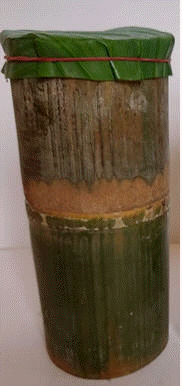 |
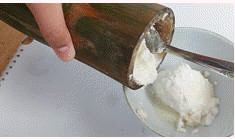 |
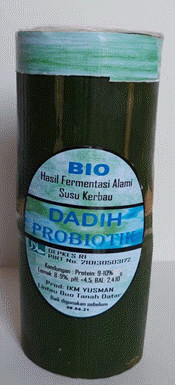 |
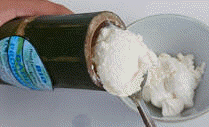 |
| Specification:
Bamboo tube 6.5 cm; height 16 cm
Cover: banana leaf tied with a rubber band Contents: 220 - 300 ml of milk Weight: 450-500 gr Labels: none | Taste: sour
Flavor: slightly rancid Color: Yellowish-white Thickness: thick |
Specification:
Bamboo tube 6.5 cm; height 16 cm
Cover: mica plastic with glue Contents: 220 - 300 ml of milk Weight: 450-500 gr Label: Sticker with trademark information, nnutritional content, halal, expiration date |
Taste: slightly sour
Flavor: smell of milk Color: milk white Thickness: very thick |
| Figure 2. Improvements to the appearance of dadih packaging to become better and more attractive | |||
The bamboo tube is the hallmark of traditional dadih packaging and affects its quality. The inner bamboo walls can spread LAB of Lactococcus, Lactobacillus, and Leuconostoc groups (Sukma et al 2017) which will help the dadih fermentation process. This part also has a high ability to absorb whey, resulting in a very thick and gives the dadih a distinctive aroma. Therefore, bamboo tube packaging needs to be maintained and improved according to the packaging requirements of food products. The traditional bamboo tube cover uses banana leaves, this can be replaced with transparent mica plastic with glue so that the dadih can be seen from the outside and resists physical influences and the possibility of spilling during the distribution process to consumers. The length of the traditional 30 cm bamboo is shortened to 16 cm to save space in packing.
The average production of buffalo milk is 4.69 liters/day, where 32.01% of this milk is used for the consumption of buffalo calves and 67.99% is used for dadih production. Dadih production has the potential to meet the protein needs of the people of West Sumatra, amounting to 63.57 g per capita. The use of an incubator can improve the quality of dadih by reducing pH 4.32, protein value 9.76, and total bacteria 2.42 x10 6 within 24 hours. Organoleptically, dadih incubated by incubator had better organoleptic sensory value than traditional incubation.Improvements in the appearance of more attractive packaging are expected to increase consumer appeal to dadih as a specific functional food for the Minangkabau community.
We thank the Agricultural Polytechnic Payakumbuh for financing the application of appropriate technology for the community to advance local food.
Amelia R, Philip K, Pratama Y E and Purwati E 2020 Characterization and probiotic potential of lactic acid bacteria isolated from dadiah sampled in West Sumatra. Food Science and Technology, 2061, 4–10. https://doi.org/10.1590/fst.30020
AOAC 2005 Official Methods of Analysis Association of Official Agriculture Chemist (W. Horwitz (ed.) 13th ed Volume 1, Issue 1) Association of Official Analytical Chemists.
BPS 2020 Statistical Yearbook of Indonesia. BPS-Statistics Indonesia, 748p.
Calandrelli M 2014 Manual on the production of traditional buffalo mozzarella cheese. In Food and Agriculture Organization (FAO), from http://www.fao.org/ag/againfo/themes/documents/milk/mozzarella.pdf
Disnak 2019 Rencana Strategis Dinas Peternakan dan Kesehatan Hewan Provinsi Sumatera Barat 2020-2025, Padang, 87p.
Ginting N 2018 Dadih bamboo ampel (Bambusa vulgaris) and bamboo gombong ( Gigantochloa verticilata) 2 and 3 days fermented: effect on salad dressing hedonic quality. IOP Conference Series: Earth and Environmental Science, 130(1). https://doi.org/10.1088/1755-1315/130/1/012029
Gomez K A and Gomez A A 1984 Statistical Procedures for Agricultural Research. John Wiley & Sons, 680p.
Huang L, Abdel-Hamid M, Romeih E, Zeng Q K, Yang P, Walker G and Li L 2020 Textural and organoleptic properties of fat-free buffalo yogurt as affected by polydextrose. International Journal of Food Properties, 23(1), 1–8. https://doi.org/10.1080/10942912.2019.1682010
Lee W J and Lucey J A 2010 Formation and physical properties of yogurt. Asian-Australasian Journal of Animal Sciences, 23(9), 1127–1136. https://doi.org/10.5713/ajas.2010.r.05
Nuraida L 2015 A review: Health promoting lactic acid bacteria in traditional Indonesian fermented foods. Food Science and Human Wellness, 4(2), 47–55. https://doi.org/10.1016/j.fshw.2015.06.001
Nybom S M K, Collado M C, Surono I S, Salminen S J and Meriluoto J A O 2008 Effect of glucose in removal of microcystin-LR by viable commercial probiotic strains and strains isolated from dadih fermented milk. Journal of Agricultural and Food Chemistry, 56(10), 3715–3720. https://doi.org/10.1021/jf071835x
Oladimeji T E, Obanla O R and Odigure J O 2016 Effects of incubation temperature on the physical and chemical properties of yoghurt. 3rd International Conference on African Development Issues, 100–102. http://eprints.covenantuniversity.edu.ng/6639/1/icadi16pp100-102.pdf
Pato U, Yusuf Y, Fitriani S, Jonnadi N N, Wahyuni S M, Feruni J A and Jaswir I 2020 Inhibitory activity of crude bacteriocin produced by lactic acid bacteria isolated from dadih against listeria monocytogenes. Biodiversitas, 21(4), 1295–1302. https://doi.org/10.13057/biodiv/d210404
Sukma A, Tah H, Tien N T T, Fitria N, Mimura I, Kaneko R, Arakawal K and Morita H 2017 Microbiota community structure in traditional fermented milk dadiah in Indonesia: Insights from high-throughput 16S rRNA gene sequencing. Milk Science International, 70, 20-22. https://openjournals.hs-hannover.de/milkscience/article/view/104.
Surono I S 2015 Traditional Indonesian dairy foods. Asia Pacific Journal of Clinical Nutrition, 24(December), S26–S30. https://doi.org/10.6133/apjcn.2015.24.s1.05
Surono I S 2016 Ethnic fermented foods and alcoholic beverages of Asia. In Ethnic Fermented Foods and Alcoholic Beverages of Asia (Issue August 2016). https://doi.org/10.1007/978-81-322-2800-4
Wijayanti M 2016 Characteristic and Development of Cow’s Milk Dadih as an Alternate of Buffalo’s Milk Dadih. Thesis, Universitas Brawijaya., Indonesia.
Wirawati C U, Sudarwanto M B, Lukman D W, Wientarsih I and Srihanto E A 2019 Diversity of lactic acid bacteria in dadih produced by either back-slopping or spontaneous fermentation from two different regions of West Sumatra, Indonesia. Veterinary World, 12(6), 823–829. https://doi.org/10.14202/vetworld.2019.823-829